Archive for the ‘Gasoline’ Category
Tuesday, June 18th, 2013
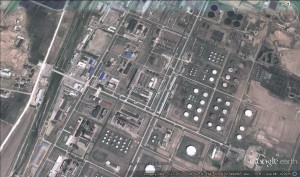
Pictured above (Google Earth): The Victory (Sungri) Refinery in Rason, North Korea.
UPDATE 2 (2016-3-25): NK News reports that HBOil refutes the claim in the Joong Ang Daily:
“HBOil JSC … hereby refutes the South Korean publication known as ‘KOREA JOONGANG DAILY’, for irresponsible reporting and dissemination of erroneous news on 23 March 2016; asserting that HBOil JSC has withdrawn from its joint venture in the Democratic People’s Republic of Korea,” the statement read.
HBOil also confirmed, “that it remains fully committed to its joint venture with Korea Oil Exploration Corporation (“KOEC”) of the DPRK, and continues its tenacious efforts to progress the joint venture’s ambition for exploration and development of hydrocarbon resources onshore North Korea.”
HBOil entered into a joint venture with North Korea in 2013 and has attempted to make inroads into North Korea’s undeveloped oil and gas sector.
The company has since invested in projects that could give it access to upstream oil and gas production and downstream refinery capacity in the coming years. However there has not been much reported movement on their North Korean project, and the outlook will not have been improved by a 70 percent drop in oil prices since last year.
While the statement affirmed HBOil’s belief that North Korea represents an “exceptional business opportunity” it also stated that the company are reviewing the implications of the recently adopted UN Security Council resolution against the country.
UPDATE 1 (2016-3-23): The Joong Ang Daily reports that HBoil is pulling out of North Korea:
A Mongolian oil company recently decided to withdraw from North Korea, a South Korean government source said, amid growing pressure from the international community after North Korea recently conducted nuclear tests and long-range missile launches.
HBOil JSC, an oil trading and refinery company based in Ulaanbaatar, Mongolia, acquired 20 percent of the North Korean entity Sungri refinery in June 2013, valued at roughly $10 million. In May 2014, the company opened a joint venture in Pyongyang.
The ex-communist country established bilateral ties with the North in 1948, but after this recent decision, the already impoverished North Korea will be further isolated from the international community.
“Mongolia is sending a message to North Korea: don’t fall down the wrong path,” said Nam Sung-wook, professor at Korea University’s Department of North Korean Studies.
North Korea formerly attracted foreign investment to resume operations of the Sungri refinery, which stopped running in 2009, in order to push for economic development. The deal with Mongolia, begun almost three years ago, was taken as evidence that North Korea wass seeking further investment partners-in addition to China.
However, the North Korean government continually delayed the inland oil development project, failing to provide reasonable explanations. Mongolia may therefore have concluded that there was no practical benefit to continuing the project.
Bilateral ties between the two countries recently turned bitter when Mongolian president Tsakhiagiin Elbegdorj said Mongolia could not endure the North’s tyranny forever, a remark made during his speech at Kim Il-sung University in Pyongyang at the end of October 2013.
“No tyranny lasts forever. It is the desire of the people to live free, that is the eternal power,” the president said in his speech. After his remarks, North Korean leader Kim Jong-un expressed disappointment and refused to hold meetings with the Mongolian president.
ORIGINAL POST (2013-6-13): Clarification: “HBOil has 20% of a state-dominated joint venture called Korean Oil Exploration Corp. International, and a formal commitment with Sungri has yet to be made. Another option is to invest in a refinery on the west coast of the DPRK.”
According to Bloomberg:
HBOil JSC, an oil trading and refining company based in Ulaanbaatar, Mongolia, said it acquired 20 percent of the state-run entity operating North Korea’s Sungri refinery, according to an e-mailed statement yesterday. It intends to supply crude to Sungri, which won’t be fully operational for up to a year, and export the refined products to Mongolia.
“Mongolia has had diplomatic relations with North Korea for many years,” Ulziisaikhan Khudree, HBOil’s chief executive officer, said in a June 12 interview in Ulaanbaatar. “There are certain risks, but other countries do business with North Korea so I am quite optimistic the project will be successful.”
The investment comes as ex-communist Mongolia seeks to power its mining-led boom while offering sanctions-hit North Korea a bridge to economic reforms. Since Swiss-educated Kim Jong Un took over the leadership of the totalitarian regime in December 2011, Mongolia has pledged to help its Soviet-era ally implement an economic transition similar to its own of the 1990s.
…
Under the transaction, worth as much as $10 million, the Mongolian Stock Exchange-listed HBOil would swap shares for full ownership of Ninox Hydrocarbons (L) Berhad, a private Malaysian company that owns 20 percent of KOEC International Inc., and issue convertible notes to fund investment at Sungri.
The rest of KOEC International is held by North Korea’s national oil company, Korea Oil Exploration Corp., which also has oil production and exploration rights in North Korea.
“This is a chance to take an equity holding in a foreign entity, and will allow us to import petroleum products, which could be lower than the current price,” said HBOil’s Khudree.
HBOil jumped by the daily limit of 15 percent to close at 253 tugrik (18 cents) on the Mongolian stock exchange today.
The deal will be the first purchase by a Mongolian-listed company of a foreign asset, according to Joseph Naemi, chief executive officer of the Ninox parent, Ninox Energy Ltd. The company is in compliance with international sanctions levied against North Korea, he said.
“If the sanctions change, and if they target the oil and gas industry, that would put us out of business, and we will have to comply,” Naemi said. “That is a risk one takes.”
Naemi said he had briefed his North Korean partners on the transaction and that “they are supportive.” No one was available to speak about the deal at North Korea’s embassy in Ulaanbaatar, which is in the middle of a renovation.
North Korea has three onshore oil basins with “proven working petroleum systems” and the country is conducting exploration for new fields, BDSec brokerage, Mongolia’s largest and the underwriter of the bonds HBOil plans to offer, said in a note to investors yesterday.
The Sungri refinery, located in the Special Economic Zone of Rason City in North Korea’s northeast, has a refining capacity of 2 million tons a year and is connected to the Russian railways system, HBOil said in its release.
Read the full story here:
Mongolia Taps North Korea Oil Potential to Ease Russian Grip
Bloomberg
Michael Kohn and Yuriy Humber
2013-6-18
Posted in Economic reform, Energy, Foreign direct investment, Gasoline, Mongolia, Oil | Comments Closed
Tuesday, December 18th, 2012
The Nautilus Institute has put together an amazing research paper on the DPRK’s energy sector. I cannot understate the value of the quality/quantity of facts/figures/tables in this research.
You can download the PDF here.
I have also added it to my DPRK Economic statistics Page.
Here is the introduction:
Energy demand and supply in general—and, arguably, demand for and supply of electricity in particular—have played a key role in many high-profile issues involving North Korea, and have played and will play a central role in the resolution of the ongoing confrontation between North Korea and much of the international community over the North’s nuclear weapons program. Energy sector issues will continue to be a key to the resolution of the crisis, as underscored by the formation of a Working Group under the Six-Party Talks that was (and nominally, still is) devoted to the issue of energy and economic assistance to the DPRK.
The purpose of this report is to provide policy-makers and other interested parties with an overview of the demand for and supply of the various forms of energy used in the DPRK in six years during the last two decades:
- 1990, the year before much of the DPRK’s economic and technical support from the Soviet Union was withdrawn;
- 1996, thought by some to be one of the most meager years of the difficult economic 1990s in the DPRK; and 2000, a year that has been perceived by some observers as a period of modest economic “recovery” in the DPRK, as well as a marker of the period before the start, in late 2002, of a period of renewed political conflict between the DPRK, the United States, and it neighbors in Northeast Asia over the DPRK’s nuclear weapons development program; and
- 2005, also a year in which observers have again noted an upward trend in some aspects of the DPRK economy, as well as the most recent year for which any published estimates on the DPRK’s energy sector and economy are available.
- 2008, the last year in which the DPRK received heavy fuel oil from its negotiating partners in the Six-Party talks; and
- 2009, the most recent year for which we have analyzed the DPRK’s energy sector.
Posted in China, Coal, Dams/hydro, Electricity, Energy, Gasoline, Natural Gas, Oil, Russia, Russian Pipeline, Solar, Wind | Comments Closed
Thursday, December 6th, 2012
Eric T. passes along this amazing satellite photo of the Korean peninsula taken at night on 2012-9-24:
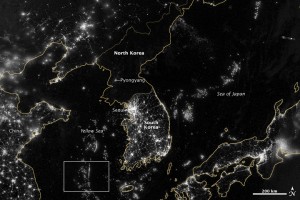
The photo comes from NASA. Click image to see larger version.
When I get some time (maybe this weekend) I will see if I can put names to the lights in North Korea.
Here is the text from the NASA web page:
City lights at night are a fairly reliable indicator of where people live. But this isn’t always the case, and the Korean Peninsula shows why. As of July 2012, South Korea’s population was estimated at roughly 49 million people, and North Korea’s population was estimated at about half that number. But where South Korea is gleaming with city lights, North Korea has hardly any lights at all—just a faint glimmer around Pyongyang.
On September 24, 2012, the Visible Infrared Imaging Radiometer Suite (VIIRS) on the Suomi NPP satellite captured this nighttime view of the Korean Peninsula. This imagery is from the VIIRS “day-night band,” which detects light in a range of wavelengths from green to near-infrared and uses filtering techniques to observe signals such as gas flares, auroras, wildfires, city lights, and reflected moonlight.
The wide-area image shows the Korean Peninsula, parts of China and Japan, the Yellow Sea, and the Sea of Japan. The white inset box encloses an area showing ship lights in the Yellow Sea. Many of the ships form a line, as if assembling along a watery border.
Following the 1953 armistice ending the Korean War, per-capita income in South Korea rose to about 17 times the per-capital income level of North Korea, according to the U.S. Central Intelligence Agency. Worldwide, South Korea ranks 12th in electricity production, and 10th in electricity consumption, per 2011 estimates. North Korea ranks 71st in electricity production, and 73rd in electricity consumption, per 2009 estimates.
Posted in Coal, Dams/hydro, Electricity, Energy, Gasoline, Nuclear, Oil, Solar, Wind | 6 Comments »
Thursday, June 25th, 2009
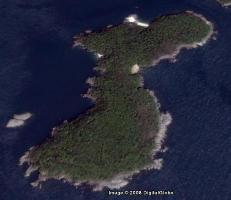 North Korea Uncovered version 18 is available. This Google Earth overlay maps North Korea’s agriculture, aviation, cultural locations, markets, manufacturing facilities, railroad, energy infrastructure, politics, sports venues, military establishments, religious facilities, leisure destinations, and national parks.
North Korea Uncovered version 18 is available. This Google Earth overlay maps North Korea’s agriculture, aviation, cultural locations, markets, manufacturing facilities, railroad, energy infrastructure, politics, sports venues, military establishments, religious facilities, leisure destinations, and national parks.
This project has now been downloaded over 140,000 times since launching in April 2007 and received much media attention last month following a Wall Street Journal article highlighting the work.
Note: Kimchaek City is now in high resolution for the first time. Information on this city is pretty scarce. Contributions welcome.
Additions to this version include: New image overlays in Nampo (infrastructure update), Haeju (infrastructure update, apricot trees), Kanggye (infrastructure update, wood processing factory), Kimchaek (infrastructure update). Also, river dredges (h/t Christopher Del Riesgo), the Handure Plain, Musudan update, Nuclear Test Site revamp (h/t Ogle Earth), The International School of Berne (Kim Jong un school), Ongjin Shallow Sea Farms, Monument to “Horizon of the Handure Plain”, Unhung Youth Power Station, Hwangnyong Fortress Wall, Kim Ung so House, Tomb of Kim Ung so, Chungnyol Shrine, Onchon Public Library, Onchon Public bathhouse, Anbyon Youth Power Stations.
Posted in Agriculture, Alcohol, Architecture, Art, Automobiles, Aviation, Banking, Coal, Communications, Construction, Dams/hydro, Education, Electricity, Energy, Environmental protection, Film, Football (soccer), Forestry, Gambling, Gasoline, General markets (FMR: Farmers Market), Golf, Google Earth, Health care, Hoteling, Hwanggumphyong and Wihwado Economic Zones (Sinuiju), Intranet, Kaesong Industrial Complex (KIC), Mass games, Mt. Kumgang Tourist Special Zone, Nuclear, Oil, Pyongyang Metro, Railways, Rason Economic and Trade Zone (Rajin-Sonbong), Religion, Restaurants, Sea shipping, Sports, Tourism, Transportation, Wind | 4 Comments »
Wednesday, March 11th, 2009
North Korea Uncovered v.16
Download it here
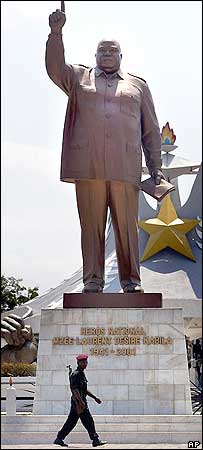
The most recent version of North Korea Uncovered (North Korea Google Earth) has been published. Since being launched, this project has been continuously expanded and to date has been downloaded over 32,000 times.
Pictured to the left is a statue of Laurent Kabila of the Democratic Republic of Congo. This statue, as well as many others identified in this version of the project, was built by the North Koreans. According to a visitor:
From the neck down, the Kabila monument looks strangely like Kim Jong Il: baggy uniform, creased pants, the raised arm, a little book in his left hand. From the neck up, the statue is the thick, grim bald mug of Laurent Kabila (his son Joseph is the current president). “The body was made in North Korea,” explains my driver Felix. In other words, the body is Kim Jong Il’s, but with a fat, scowling Kabila head simply welded on.
This is particularly interesting because there are no known pictures of a Kim Jong il statue. The only KJI statue that is reported to exist is in front of the National Security Agency in Pyongyang. If a Kim Jong il statue does in fact exist, it might look something like this.
Thanks again to the anonymous contributors, readers, and fans of this project for your helpful advice and location information. This project would not be successful without your contributions.
Version 16 contains the following additions: Rakwon Machine Complex, Sinuiju Cosmetics Factory, Manpo Restaurant, Worker’s Party No. 3 Building (including Central Committee and Guidance Dept.), Pukchang Aluminum Factory, Pusan-ri Aluminum Factory, Pukchung Machine Complex, Mirim Block Factory, Pyongyang General Textile Factory, Chonnae Cement Factory, Pyongsu Rx Joint Venture, Tongbong Cooperative Farm, Chusang Cooperative Farm, Hoeryong Essential Foodstuff Factory, Kim Ki-song Hoeryong First Middle School , Mirim War University, electricity grid expansion, Tonghae Satellite Launching Ground (TSLG)” is also known as the “Musudan-ri Launching Station,” rebuilt electricity grid, Kumchang-ri suspected underground nuclear site, Wangjaesan Grand Monument, Phothae Revolutionary Site, Naedong Revolutionary Site, Kunja Revolutionary Site, Junggang Revolutionary Site, Phophyong Revolutionary Site, Samdung Revolutionary Site, Phyongsan Granite Mine, Songjin Iron and Steel Complex (Kimchaek), Swedish, German and British embassy building, Taehongdan Potato Processing Factory, Pyongyang Muyseum of Film and Theatrical Arts, Overseas Monuments built by DPRK: Rice Museum (Muzium Padi) in Malaysia, Statue de Patrice Lumumba (Kinshasa, DR Congo), National Heroes Acre (Windhoek, Namibia), Derg Monument (Addis Ababa, Ethiopia), National Heroes Acre (Harare, Zimbabwe), New State House (Windhoek, Namibia), Three Dikgosi (Chiefs) Monument (Gaborone, Botswana), 1st of May Square Statue of Agostinho Neto (Luanda, Angola), Momunment Heroinas Angolas (Luanda, Angola), Monument to the Martyrs of Kifangondo Battle (Luanda, Angola), Place de l’étoile rouge, (Porto Novo, Benin), Statue of King Béhanzin (Abomey, Benin), Monument to the African Renaissance (Dakar, Senegal), Monument to Laurent Kabila [pictured above] (Kinshasa, DR Congo).
Posted in Agriculture, Architecture, Art, Automobiles, Aviation, Banking, Coal, Communications, Computing/IT, Construction, Dams/hydro, Education, Electricity, Energy, Environmental protection, Figure skating, Film, Finance, Fiscal & monetary policy, Food, Football (soccer), Forestry, Gambling, Gasoline, General markets (FMR: Farmers Market), Golf, Google Earth, Health care, Hoteling, Hwanggumphyong and Wihwado Economic Zones (Sinuiju), Intranet, Kaesong Industrial Complex (KIC), Leisure, Library, Light Industry, Mansudae Overseas Development Group, Manufacturing, Mass games, Military, Mining/Minerals, Mt. Kumgang Tourist Special Zone, Music, Nuclear, Oil, Pyongyang Metro, Railways, Rason Economic and Trade Zone (Rajin-Sonbong), Real estate, Religion, Restaurants, Sea shipping, Special Economic Zones (Established before 2013), Sports, Telephones, Television, Tourism, Transportation, Water, Wind | 10 Comments »
Tuesday, January 27th, 2009
From the Daily NK:
A source from Yangkang Province reported on the 27th in a telephone conversation with the Daily NK that, “On the 15th in Woonheung, 8 freight wagons carrying a total of 480 tons of gasoline and diesel overturned at dawn. The National Security Agency and the provincial security agency are examining the causes of the incident.”
In Youngha Workers-gu, which adjoins Baekam where this incident occurred, a train on the Hyesan-Pyongyang line overturned on March 27th, 2008, killing or wounding hundreds.
According to the source, there were 16 casualties, including merchants and an engineer on the freight train. 8 freight wagons completely overturned, causing the spill.
Right after the incident, North Korean authorities mobilized citizens to deal with it and dispatched the NSA to examine the causes.
The source said that, “As the train was going down a slope, a blackout occurred so the brakes did not work. However, the NSA presumes it happened deliberately, because similar incidents have occurred in this region.”
The North Korean authorities have been claiming to citizens that such incidents, which happen every year in Youngha Workers-gu, Woonheung and Baekam in Yangkang Province, are maneuvers by enemies. However, no criminals have been detained.
Thoughts:
1. The DPRK’s railway system is outdated to say the least. Many of the lines were laid during the Japanese occupation of the peninsula (pre-WWII). After the Korean war, large sections were reconstructed, but needless to day, for the last 50+ years the system has suffered severe under-investment. Recently it has been targeted as a major focus of the policy to create a “strong and prosperous nation” by 2012.
2. We know from multiple tourists that the Pyongyang-Sinuiju line is operational. We now know that the line from the Russian border to Pyongyang is operational. Other than these two lines, the functionality of the DPRK’s railway system is largely a mystery to the outside world.
3. The Daily NK also reported a DPRK railway accident in April 2008 (here and here).
4. No word yet on whether the DPRK purchased life insurance for the passengers!
5. An excellent map of the DPRK’s railway system can be downloaded to Google Earth here.
6. You can read past blog posts about the DPRK’s railway system here.
You can read the full Daily NK story here:
Freight Train Overturned in Yangkang, 16 Casualties
Daily NK
Lee Sung Jin
1/27/2009
Posted in Energy, Gasoline, Oil, Railways, Transportation | Comments Closed
Thursday, October 2nd, 2008
North Korea Uncovered: Version 12
Download it here
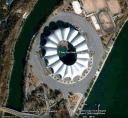 About this Project: This map covers North Korea’s agriculture, aviation, cultural locations, markets, manufacturing facilities, energy infrastructure, political facilities, sports venues, military establishments, religious facilities, leisure destinations, national parks, shipping, mining, and railway infrastructure. It is continually expanding and undergoing revisions. This is the 12th version.
About this Project: This map covers North Korea’s agriculture, aviation, cultural locations, markets, manufacturing facilities, energy infrastructure, political facilities, sports venues, military establishments, religious facilities, leisure destinations, national parks, shipping, mining, and railway infrastructure. It is continually expanding and undergoing revisions. This is the 12th version.
Additions include: Tongch’ang-dong launch facility overlay (thanks to Mr. Bermudez), Yongbyon overlay with destroyed cooling tower (thanks to Jung Min Noh), “The Barn” (where the Pueblo crew were kept), Kim Chaek Taehung Fishing Enterprise, Hamhung University of education, Haeju Zoo, Pyongyang: Kim il Sung Institute of Politics, Polish Embassy, Munsu Diplomatic Store, Munsu Gas Station, Munsu Friendship Restaurant, Mongolian Embassy, Nigerian Embassy, UN World Food Program Building, CONCERN House, Czech Republic Embassy, Rungnang Cinema, Pyongyang University of Science and Technology, Pyongyang Number 3 Hospital, Electric Machines Facotry, Bonghuajinlyoso, Second National Academy of Sciences, Central Committee Building, Party Administration Building, Central Statistics Bureau, Willow Capital Food House, Thongounjong Pleasure Ground, Onpho spa, Phipa Resort Hotel, Sunoni Chemical Complex (east coast refinery), Ponghwa Chemical complex (west coast refinery), Songbon Port Revolutionary Monument, Hoeryong People’s Library, Pyongyang Monument to the anti Japanese martyrs, tideland reclamation project on Taegye Island. Additionally the electricity grid was expanded and the thermal power plants have been better organized. Additional thanks to Ryan for his pointers.
I hope this map will increase interest in North Korea. There is still plenty more to learn, and I look forward to receiving your contributions to this project.
Version 12 available: Download it here
Posted in Agriculture, Animation, Architecture, Art, Automobiles, Aviation, Banking, Cell phones, Coal, Communications, Computing/IT, Construction, Copper, Dams/hydro, Education, Electricity, Energy, Environmental protection, Film, Finance, Fiscal & monetary policy, Food, Football (soccer), Foreign direct investment, Forestry, Gambling, Gasoline, General markets (FMR: Farmers Market), Gold, Golf, Google Earth, Health care, Hoteling, Hwanggumphyong and Wihwado Economic Zones (Sinuiju), International trade, Joint Ventures, Kaesong Industrial Complex (KIC), Leisure, Library, Light Industry, Lumber, Manufacturing, Mass games, Military, Mining/Minerals, Mt. Kumgang Tourist Special Zone, Music, Nuclear, Pyongyang Metro, Railways, Rason Economic and Trade Zone (Rajin-Sonbong), Real estate, Religion, Restaurants, Sea shipping, Special Economic Zones (Established before 2013), Sports, Television, Tourism, Transportation, Wind | 1 Comment »
Thursday, August 14th, 2008
The most authoritative map of North Korea on Google Earth
Download it here
 This map covers North Korea’s agriculture, aviation, cultural locations, markets, manufacturing facilities, railroad, energy infrastructure, politics, sports venues, military establishments, religious facilities, leisure destinations, and national parks. It is continually expanding and undergoing revisions. This is the eleventh version.
This map covers North Korea’s agriculture, aviation, cultural locations, markets, manufacturing facilities, railroad, energy infrastructure, politics, sports venues, military establishments, religious facilities, leisure destinations, and national parks. It is continually expanding and undergoing revisions. This is the eleventh version.
Additions include: Mt. Paegun’s Ryonghung Temple and resort homes, Pyongyang’s Chongryu Restaurant, Swiss Development Agency (former UNDP office), Iranian Embassy, White Tiger Art Studio, KITC Store, Kumgangsan Store, Pyongyang Fried Chicken Restaurant, Kilju’s Pulp Factory (Paper), Kim Chaek Steel Mill, Chongjin Munitions Factory, Poogin Coal Mine, Ryongwun-ri cooperative farm, Thonggun Pavilion (Uiju), Chinju Temple (Yongbyon), Kim il Sung Revolutionary Museum (Pyongsong), Hamhung Zoo, Rajin electrified perimeter fence, Pyongsong market (North Korea’s largest), Sakju Recreation Center, Hoeryong Maternity Hospital, Sariwon Suwon reservoir (alleged site of US massacre), Sinpyong Resting Place, 700 Ridges Pavilion, Academy of Science, Hamhung Museum of the Revolutionary Activities of Comrade Kim Il Sung, South Hamgyong House of Culture, Hamhung Royal Villa, Pork Chop Hill, and Pyongyang’s Olympic torch route. Additional thanks go to Martyn Williams for expanding the electricity grid, particularly in Samjiyon, and various others who have contributed time improving this project since its launch.
Disclaimer: I cannot vouch for the authenticity of many locations since I have not seen or been to them, but great efforts have been made to check for authenticity. These efforts include pouring over books, maps, conducting interviews, and keeping up with other peoples’ discoveries. In many cases, I have posted sources, though not for all. This is a thorough compilation of lots of material, but I will leave it up to the reader to make up their own minds as to what they see. I cannot catch everything and I welcome contributions. Additionally, this file is getting large and may take some time to load.
Posted in Advertising, Agriculture, Architecture, Art, Automobiles, Aviation, Banking, Biotech, Cell phones, Central Broadcasting Station, Coal, Committee for Cultural Relations with Foreign Countries, Communications, Computing/IT, Construction, Dams/hydro, Demographics, Domestic publication, Education, Electricity, Energy, Environmental protection, Film, Finance, Food, Football (soccer), Foreign direct investment, Forestry, Gambling, Gasoline, General markets (FMR: Farmers Market), Golf, Google Earth, Health care, Hoteling, Hwanggumphyong and Wihwado Economic Zones (Sinuiju), Intranet, Joint Ventures, Kaesong Industrial Complex (KIC), Kim Il Sung University, Korean Buddhist Association, Labor conditions/wages, Leisure, Library, Light Industry, Lumber, Mansu Art Studio, Manufacturing, Mass games, Maternity Hospital, Military, Mining/Minerals, Ministry of foreign Affairs, Ministry of Foreign Trade, Ministry of People’s Armed Forces, Ministry of Post and Telecommunications, Ministry of Public Health, Mt. Kumgang Tourist Special Zone, Musan Mine, Nuclear, Oil, Phoenix Commerical Ventures, Pyongyang Embroidery Institute, Pyongyang Film Studio, Pyongyang International Information Center of New Techn, Pyongyang International Trade Fair, Pyongyang Metro, Pyongyang University of Medicine, Radio, Railways, Rason Economic and Trade Zone (Rajin-Sonbong), Real estate, Religion, Restaurants, Sea shipping, Sports, Steel, Supreme Peoples Assembly, Tourism, Transportation, Wind | 6 Comments »
Saturday, May 10th, 2008
From the Nautilus Institute (presentations at bottom):
Background
Energy insecurity is a critical dimension of the North Korean (DPRK) nuclear challenge, both in its making, and in its reversal. One of the Six-Party Talks working groups, the Economy and Energy Working Group, is largely devoted to this topic, and energy assistance will play an important role in the process of denuclearization of the DPRK. Nautilus Institute maintains a unique database and set of quantitative and qualitative analytic tools to evaluate and track the DPRK’s energy economy, and has maintained working relations with North Korean scientists and technical personnel from the energy sector for more than a decade. With this capacity, Nautilus has provided a stream of policy analyses and briefings at their request to US, ROK and other officials on the DPRK’s energy needs, its likely negotiating postures and demands, and possible negotiable options. The need for such expertise in support of the Six-Party Talks is increasing.
This project ensures that the underlying data and technical analysis available at Nautilus is as up-to-date as possible, and that analysis and policy advice are available when needed by US and other officials.
The Second DPRK Energy Experts’ Working Group (2008) served to provide information and views from key experts in the field to inform the Nautilus DPRK energy sector analysis update. Experts in attendance at the meeting provided both pertinent, recent data and special insights that are being used to help to make the database as reflective as possible of actual conditions in the DPRK. This in turn provides crucial input to the analysis needed to help to inform the parties to the 6-Party talks regarding possible approaches to DPRK energy sector redevelopment.
In addition, the DPRK Energy Experts Study Group Meeting served, as did the first Meeting, as an opportunity for experts on the DPRK to exchange views on the appropriate “next steps” in DPRK energy sector redevelopment. Key outcomes of this discussion are being reflected in the updated DPRK Energy Sector Analysis. In the process of discussions, the experts in attendance helped to further develop and elaborate-as well as providing input on the prospects for-the activities and means by which the various parties concerned with Korean peninsula affairs might engage and work with the DPRK to help resolve both the DPRK’s energy problems, and, in so doing, begin to address and ameliorate the regional and global insecurities of which the DPRK’s energy problems are a key part. In particular, through the focus of the second day of the meeting on Building Energy Efficiency, progress was made on consideration of possible benefits from and approaches to improving the effectiveness of energy use in the crucial DPRK buildings sector.
The Second DPRK Energy Experts Study Group Meeting convened by Nautilus and its partners will was attended by experts in a variety of areas related to energy supply and demand in the DPRK-including electricity, coal and other minerals, the DPRK economy as a whole, trade into and from the DPRK, and the DPRK’s rural household and agricultural sectors, and energy use in buildings in general in the DPRK and elsewhere (the primary topic of the second day of the Meeting)-to review and discuss the results of existing and newly-commissioned research, and to provide insights from their own experience and their own research. A total of approximately 15 experts on the DPRK and on matters related to DPRK issues attended the Meeting, not including an additional 15 experts, representatives from the organizations partnering to fund and organize the meeting (Nautilus, Tsinghua University, USDOE), including observers from bilateral aid agencies associated with a number of countries, from international organizations, from the business sector, and others, who also lent their expertise to the workshop. On the second day of the workshop, supported by funding from a private foundation, a five-member delegation from the DPRK also attended the meeting, providing presentations and insights of their own on energy use in DPRK buildings, and on related energy sector problems and plans in the DPRK.
Presentations:
Presentation: North Korea’s Mineral Resources and Inter-Korean Cooperation
By Woo-jin Chung
Presentation: Nautilus Institute’s Analysis of the DPRK Energy Sector and DPRK Energy Paths: Update
By David von Hippel
Presentation: Analysis on DPRK Power Sector Data & Interconnection Option
By Yoon Jae-young
Presentation: DPRK Energy and Energy-Related Trade with China: Trends Since 2005
By Nate Aden
Posted in Coal, Copper, Dams/hydro, Electricity, Energy, Environmental protection, Forestry, Gasoline, Gold, Graphite, Iron Ore, Lumber, Mining/Minerals, Natural Gas, Nuclear, Oil, Wind | Comments Closed
Sunday, November 11th, 2007
The most authoritative map of North Korea on Google Earth
North Korea Uncovered: Version 6
Download it here
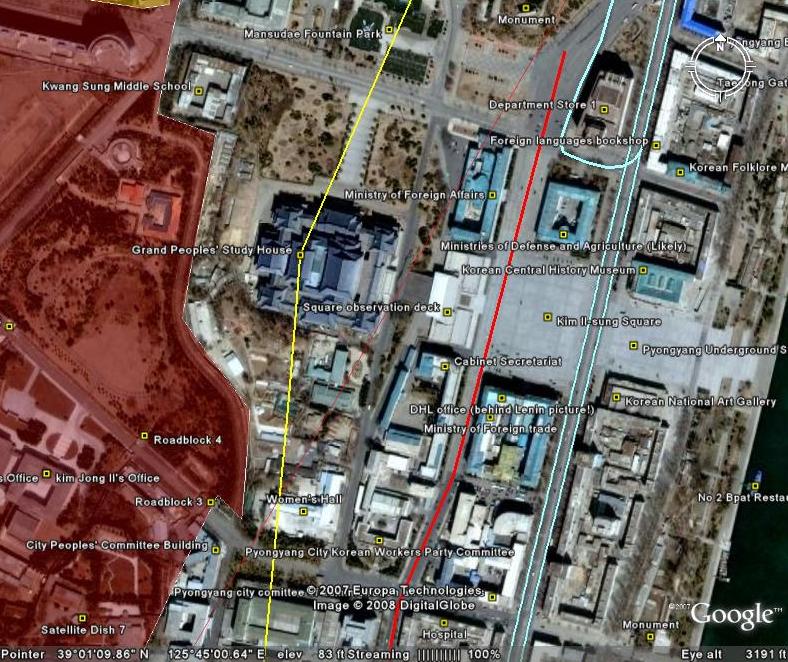 This map covers North Korea’s agriculture, aviation, cultural locations, manufacturing facilities, railroad, energy infrastructure, politics, sports venues, military establishments, religious facilities, leisure destinations, and national parks. It is continually expanding and undergoing revisions. This is the sixth version.
This map covers North Korea’s agriculture, aviation, cultural locations, manufacturing facilities, railroad, energy infrastructure, politics, sports venues, military establishments, religious facilities, leisure destinations, and national parks. It is continually expanding and undergoing revisions. This is the sixth version.
Additions to the newest version of North Korea Uncovered include: Alleged Syrian nuclear site (before and after bombing), Majon beach resort, electricity grid expansion, Runga Island in Pyongyang, Mt. Ryongak, Yongbyon historical fort walls, Suyang Fort walls and waterfall in Haeju, Kaechon-Lake Taesong water project, Paekma-Cholsan waterway, Yachts (3), and Hyesan Youth Copper Mine.
Disclaimer: I cannot vouch for the authenticity of many locations since I have not seen or been to them, but great efforts have been made to check for authenticity. These efforts include pouring over books, maps, conducting interviews, and keeping up with other peoples’ discoveries. In many cases, I have posted sources, though not for all. This is a thorough compilation of lots of material, but I will leave it up to the reader to make up their own minds as to what they see. I cannot catch everything and I welcome contributions.
Posted in Advertising, Agriculture, Architecture, Automobiles, Aviation, Banking, Black markets, Committee for Cultural Relations with Foreign Countries, Communications, Computing/IT, Dams/hydro, Department Store No. 1, Economic reform, Education, Electricity, Energy, Environmental protection, Film, Finance, Fiscal & monetary policy, Football (soccer), Forestry, Gambling, Gasoline, General markets (FMR: Farmers Market), Golf, Google Earth, Hana Electronics Company, Health care, Hoteling, Hwanggumphyong and Wihwado Economic Zones (Sinuiju), Hyesan Youth Cooper Mine, Kaesong Industrial Complex (KIC), Kim Il Sung University, Korea Computer Center (KCC), Library, Light Industry, Mansudae creative Company (art studio), Manufacturing, Mass games, Maternity Hospital, Military, Mining/Minerals, Ministry of Culture, Ministry of Foreign Trade, Mt. Kumgang Tourist Special Zone, Musan Mine, Music, Nuclear, Pyongyang Embroidery Institute, Pyongyang Film Studio, Pyongyang Informatics Center (PIC), Pyongyang International Information Center of New Techn, Pyongyang International Trade Fair, Pyongyang Metro, Railways, Rason Economic and Trade Zone (Rajin-Sonbong), Real estate, Religion, Restaurants, Sea shipping, Special Economic Zones (Established before 2013), Sports, Steel, Supreme Peoples Assembly, Television, Tourism, Transportation, Water, Wind | Comments Closed



